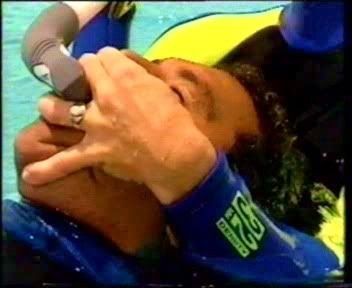Angela2932
Registered
Hi everyone!
I'm hoping to re-take (long story) the pool portion of my PADI open water certification in September. In preparation for this, I've been doing lap swims in the local YMCA with my fins, snorkel and mask. Today, I worked on taking off the fins, replacing them, flooding and clearing the mask, and then tried taking off the mask and replacing it underwater. I ran into a gliche in that I couldn't seem to clear the snorkel. It's not one I bought at a dive shop, but at a sporting good store. It's got a valve that closes off as you go under water. But I'm really not being very successful at clearing it! I thought it should just take a strong force of air blowing out. . . . .but nothing but gurgles! I stood for awhile in the shallow end, filling it with water, and trying to clear the water. .. . but just gurgles! It's not like I have a lung problem or anything!
Than I tried occasional snorkeling/swimming along, and diving down toward the bottom of the water, as part of my "get more comfortable in the water." But when I would surface, expecting the valve to open, it wouldn't. I can reach up and manually move it open, but is this the way it's suppose to work?
So, is it more practical to have a snorkel that DOESN'T have this "dry" valve feature?
Thanks for any thoughts on this!
I'm hoping to re-take (long story) the pool portion of my PADI open water certification in September. In preparation for this, I've been doing lap swims in the local YMCA with my fins, snorkel and mask. Today, I worked on taking off the fins, replacing them, flooding and clearing the mask, and then tried taking off the mask and replacing it underwater. I ran into a gliche in that I couldn't seem to clear the snorkel. It's not one I bought at a dive shop, but at a sporting good store. It's got a valve that closes off as you go under water. But I'm really not being very successful at clearing it! I thought it should just take a strong force of air blowing out. . . . .but nothing but gurgles! I stood for awhile in the shallow end, filling it with water, and trying to clear the water. .. . but just gurgles! It's not like I have a lung problem or anything!
Than I tried occasional snorkeling/swimming along, and diving down toward the bottom of the water, as part of my "get more comfortable in the water." But when I would surface, expecting the valve to open, it wouldn't. I can reach up and manually move it open, but is this the way it's suppose to work?
So, is it more practical to have a snorkel that DOESN'T have this "dry" valve feature?
Thanks for any thoughts on this!
Last edited:







